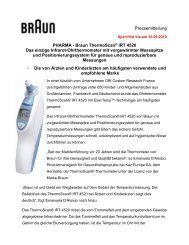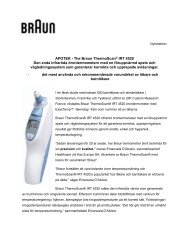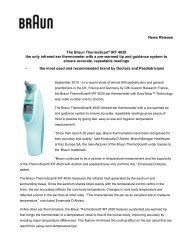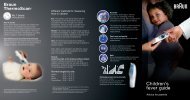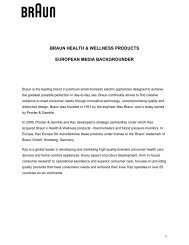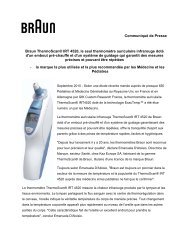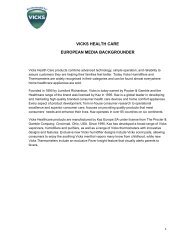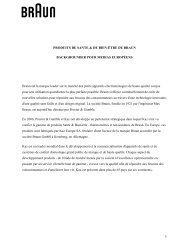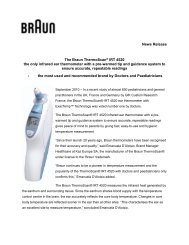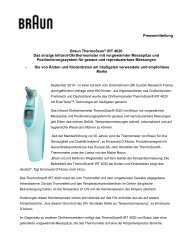ThermoScan - Kaz Europe SA
ThermoScan - Kaz Europe SA
ThermoScan - Kaz Europe SA
You also want an ePaper? Increase the reach of your titles
YUMPU automatically turns print PDFs into web optimized ePapers that Google loves.
6026360_KAZ_IRT3020 Seite 2 Montag, 13. August 2007 1:16 13<br />
5<br />
6<br />
1 2 3 4<br />
<strong>ThermoScan</strong><br />
start start<br />
7
English<br />
The Braun <strong>ThermoScan</strong> thermometer has been<br />
carefully developed for accurate, safe and fast<br />
temperature measurements in the ear. The shape<br />
of the thermometer probe prevents it from being<br />
inserted too far into the ear canal and hurting the<br />
eardrum.<br />
However, as with any thermometer,<br />
proper technique is very important<br />
to obtaining accurate temperatures.<br />
Therefore, read the use instructions<br />
carefully and thoroughly.<br />
Important<br />
• The operating ambient temperature range for<br />
this thermometer is 50 – 104 °F (10 – 40 °C).<br />
• Do not expose the thermometer to temperature<br />
extremes (below –4 °F / –20 °C or over 122 °F /<br />
50 °C) nor excessive humidity (> 95 % RH).<br />
• This thermometer must only be used with<br />
genuine Braun <strong>ThermoScan</strong> Lens Filters. Other<br />
lens filters can lead to inaccuracy.<br />
• To avoid inaccurate measurements always use<br />
this thermometer with a new, clean lens filter<br />
attached.<br />
• If the thermometer is accidentally used without<br />
a lens filter attached, clean the lens (see «Care<br />
and cleaning»).<br />
• Keep lens filters out of reach of children.<br />
• This thermometer is intended for household<br />
use only.<br />
• Use of this thermometer is not intended as a<br />
substitute for consultation with your physician.<br />
Body temperature<br />
Normal body temperature is a range. The following<br />
table shows that this normal range also varies by<br />
site. Therefore, measurements from different sites<br />
should not be directly compared.<br />
Normal ranges by site:<br />
Axillary 1 : 94.5 – 99.1 °F 34.7 – 37.3 °C<br />
Oral 1 : 95.9 – 99.5 °F 35.5 – 37.5 °C<br />
Rectal 1 : 97.9 – 100.4 °F 36.6 – 38.0 °C<br />
<strong>ThermoScan</strong> 2 : 96.4 – 100.4 °F 35.8 – 38.0 °C<br />
• A person’s normal temperature range tends to<br />
decrease with age. The following table shows<br />
normal <strong>ThermoScan</strong> ranges by age.<br />
Normal <strong>ThermoScan</strong> ranges by age 2 :<br />
0 – 2 years 97.5 – 100.4 °F 36.4 – 38.0 °C<br />
3 – 10 years 97.0 – 100.0 °F 36.1 – 37.8 °C<br />
11 – 65 years 96.6 – 99.7 °F 35.9 – 37.6 °C<br />
> 65 years 96.4 – 99.5 °F 35.8 – 37.5 °C<br />
The range of normal also varies from person to<br />
person and fluctuates throughout the day.<br />
It is therefore important to determine normal<br />
temperature ranges. This is easily done using<br />
Braun <strong>ThermoScan</strong>. Practice taking temperatures<br />
on yourself and healthy family members to<br />
determine each person’s normal temperature<br />
range.<br />
Note: When consulting your physician, communicate<br />
that the <strong>ThermoScan</strong> temperature is a<br />
temperature measured in the ear and if possible,<br />
note the individual’s normal <strong>ThermoScan</strong><br />
temperature range as additional reference.<br />
1. Chamberlain, J.M., Terndrup, T.E., New Light on Ear Thermometer<br />
Readings, Contemporary Pediatrics, March 1994.<br />
2. Chamberlain, J.M., et al., Determination of Normal Ear<br />
Temperature with an Infrared Emission Detection Thermometer,<br />
Annals of Emergency Medicine, January 1995.<br />
3<br />
6026360_KAZ_IRT3020 Seite 3 Montag, 13. August 2007 1:16 13
Product description<br />
1 Protective cap<br />
2 Lens filter<br />
3 Probe<br />
4 «start» button<br />
5 Lens filter detector<br />
6 Display<br />
7 Battery door<br />
How to use your Braun <strong>ThermoScan</strong><br />
1. To achieve accurate<br />
measurements, make sure a<br />
new, clean lens filter (2) is in<br />
place before each measurement.<br />
4<br />
6026360_KAZ_IRT3020 Seite 4 Montag, 13. August 2007 1:16 13<br />
<strong>ThermoScan</strong><br />
LF 20<br />
2. To turn the thermometer on,<br />
push the «start» button (4).<br />
During an internal selfcheck,<br />
the display (6) shows<br />
all segments. Then the last<br />
temperature taken will be<br />
displayed together with<br />
«MEM».<br />
As soon as this ready<br />
symbol appears, you can<br />
start the measuring<br />
process.<br />
3. Perform an ear tug to straighten the ear canal.<br />
This gives the thermometer a clear view of the<br />
eardrum.<br />
An ear tug is best performed by using your free<br />
hand to grasp the outer edge of the top half of<br />
the ear. To take your own temperature, wrap<br />
your free hand around the back of your head<br />
and tug your ear from behind.<br />
Children under 1 year:<br />
Pull the ear straight back.<br />
Children aged 1 year to<br />
adult:<br />
Pull the ear up and back.<br />
4. While tugging the ear, fit the<br />
probe (3) snugly into the ear<br />
canal, then push the «start»<br />
button. A short beep will<br />
signal the start of the<br />
measuring process.<br />
After one second a longer<br />
beep will signal the end<br />
of the measuring process.<br />
The result is shown on the<br />
display (6).
5. For the next measurement,<br />
remove the used lens filter<br />
and put on a new, clean lens<br />
filter. Clear the display by<br />
pushing the «start» button<br />
once. Fit the probe snugly<br />
into the ear canal, then push<br />
the «start» button.<br />
The Braun <strong>ThermoScan</strong> ear thermometer turns off<br />
automatically after 60 seconds of inactivity.<br />
Temperature taking hints<br />
• The right ear measurement may differ from<br />
the measurement taken in the left ear.<br />
Therefore, always take the temperature in<br />
the same ear.<br />
• The ear must be free from obstructions or<br />
excess earwax build-up to take an accurate<br />
reading.<br />
• External factors may influence ear temperatures,<br />
including when an individual has:<br />
– been lying on one ear or the other<br />
– had their ears covered<br />
– been exposed to very hot or very cold<br />
temperatures, or<br />
– been recently swimming or bathing.<br />
In these cases, remove the individual from the<br />
situation and wait 20 minutes prior to taking a<br />
temperature.<br />
• Use the untreated ear if ear drops or other ear<br />
medications have been placed in the ear canal.<br />
Care and cleaning<br />
The probe tip is the most delicate part of the<br />
thermometer. It has to be clean and intact to<br />
ensure accurate readings.<br />
If the thermometer is ever<br />
accidentally used without a lens<br />
filter, clean the probe tip as<br />
follows:<br />
Very gently wipe the surface<br />
with a cotton swab or soft cloth<br />
moistened with alcohol.<br />
After the probe tip has completely dried, you can<br />
put a new lens filter on and take a temperature<br />
measurement. If the probe tip is damaged, contact<br />
<strong>Kaz</strong>.<br />
Use a soft, dry cloth to clean the thermometer<br />
display and exterior. Do not use abrasive cleaners.<br />
Never submerge this thermometer in water or any<br />
other liquid.<br />
Store thermometer and lens filters in a dry location<br />
free from dust and contamination and away from<br />
direct sunlight.<br />
Additional lens filters (LF 40) are available at most<br />
stores carrying Braun <strong>ThermoScan</strong>.<br />
Trouble-shooting<br />
5<br />
6026360_KAZ_IRT3020 Seite 5 Montag, 13. August 2007 1:16 13<br />
Situation Solution<br />
No lens filter<br />
is attached.<br />
Attach new, clean lens<br />
filter.<br />
Ambient Allow the thermometer<br />
temperature to remain for 30 min-<br />
is not within utes in a room where<br />
the allowed the temperature is be-<br />
operating tween 50 and 104 °F<br />
range<br />
(50 –104 °F<br />
or 10 – 40 °C).<br />
or 10 and 40 °C .
Changing the temperature scale<br />
Your Braun <strong>ThermoScan</strong> is shipped with the<br />
Fahrenheit (°F) temperature scale activated. If you<br />
wish to switch to Celsius (°C), proceed as follows:<br />
Make sure the thermometer is turned off.<br />
Press and hold down the «start» button. After<br />
about 8 seconds the display will show this<br />
sequence: «°F» / «°C» /...<br />
Release the «start» button when «°C» is shown.<br />
There will be a short beep to confirm the new<br />
setting, then the thermometer is turned off<br />
automatically.<br />
Replacing the battery<br />
6<br />
6026360_KAZ_IRT3020 Seite 6 Montag, 13. August 2007 1:16 13<br />
HI = too high<br />
LO = too low<br />
Temperature taken is<br />
not within typical<br />
human temperature<br />
range (93.2 –108 °F or<br />
34 – 42.2 °C).<br />
If error persists,<br />
System error<br />
Make sure the probe tip<br />
and lens are clean and a<br />
new, clean lens filter is<br />
attached. Make sure<br />
the thermometer is<br />
properly inserted into<br />
the ear. Then, take a<br />
new temperature<br />
measurement.<br />
Wait 1 minute until the<br />
thermometer turns off<br />
automatically, then turn<br />
on again.<br />
... reset the thermometer<br />
by removing the<br />
battery and putting it<br />
back in.<br />
If error still persists, … call <strong>Kaz</strong> Customer<br />
Service at<br />
1-800-327-7226<br />
Battery is Insert new battery.<br />
low, but<br />
thermometer<br />
will still<br />
operate<br />
correctly.<br />
Battery is too Insert new battery.<br />
low to take<br />
correct temperature<br />
measurement.<br />
Do you have any further<br />
questions?<br />
Call <strong>Kaz</strong> Customer<br />
Service.<br />
The thermometer is supplied<br />
with one 1.5 V type AAA (LR3).<br />
For best performance, we<br />
recommend Duracell ® alkaline<br />
batteries. Insert new battery<br />
when the battery symbol<br />
appears on the display.<br />
Open the battery compartment.<br />
Remove the battery and replace<br />
with new battery, making<br />
sure the poles are in the right<br />
direction. Slide battery door<br />
back until it snaps in place.
7<br />
6026360_KAZ_IRT3020 Seite 7 Montag, 13. August 2007 1:16 13<br />
To protect the environment, dispose of<br />
empty batteries at appropriate collection<br />
sites according to national or local<br />
regulations.<br />
Calibration<br />
The thermometer is initially calibrated at the<br />
time of manufacture. If this thermometer is used<br />
according to the use instructions, periodic readjustment<br />
is not required. If at any time you<br />
question the accuracy of temperature measurements,<br />
please contact <strong>Kaz</strong> Customer Service<br />
at 1-800-327-7226.<br />
Manufacturing date is given by the LOT number<br />
located in the battery compartment. The first<br />
number after LOT represents the last digit of the<br />
year of manufacture.<br />
The last two digits give the week of manufacture.<br />
An example: LOT 503 – this product has been<br />
manufactured in week 03 of the year 2005.<br />
Product specifications<br />
Displayed temperature range: 93.2 °F – 108 °F<br />
(34 °C – 42.2 °C)<br />
Operating ambient<br />
temperature range: 50 °F – 104 °F<br />
(10 °C – 40 °C)<br />
Display resolution: 0.1 °F or °C<br />
Accuracy for patient Maximum Laboratory<br />
temperature range Error<br />
96.8 °F – 102.2 °F<br />
(36 °C – 39 °C): ± 0.4 °F (± 0.2 °C)<br />
outside this range: ± 0.5 °F (± 0.3 °C)<br />
Long term storage ranges<br />
Temperature: –4 °F to 122 °F<br />
(–20 °C to 50 °C)<br />
Humidity: ≤ 95 % noncondensing<br />
Battery life: 2 years / 1000<br />
measurements<br />
If device is not used within specified temperature<br />
and humidity ranges the technical accuracy can<br />
not be ensured.<br />
This infrared thermometer meets requirements<br />
established in ASTM Standard E 1965-98 (for the<br />
thermometer system [thermometer with lens filter]).<br />
Full responsibility for the conformance of the<br />
product to the standard is assumed by<br />
<strong>Kaz</strong>, Inc., Hudson, NY 12534 U<strong>SA</strong>.<br />
ASTM laboratory accuracy requirements for the<br />
thermometer only (not including a lens filter) in<br />
the display range of 96.8 °F to 102.2 °F (36 °C<br />
to 39 °C) for infrared thermometers is ± 0.4 °F<br />
(± 0.2 °C), whereas for mercury-in-glass and<br />
electronic thermometers, the requirement per<br />
ASTM Standards E 667-86 and E 1112-86 is<br />
± 0.2 °F (± 0.1 °C).<br />
This appliance conforms to the following<br />
standards:<br />
DIN EN 60601-1: 3/96 «Medical electrical<br />
equipment» – Part 1: General requirements for<br />
safety<br />
DIN EN 60601-1-2/2001 «Medical electrical<br />
equipment» – Part 1-2: General requirements for safety<br />
– collateral standard: Electromagnetic compatibility –<br />
requirements and tests<br />
DIN EN 12470-5: 2003 «Clinical thermometers» –<br />
Part 5: Performance of infrared ear thermometers<br />
(with maximum device)
Internally Powered Equipment<br />
Continuous Operation<br />
Not Protected against Ingress of Water<br />
U.S. Patent No. 5,088,834 Other Patents Pending<br />
MEDICAL ELECTRICAL EQUIPMENT needs<br />
special precautions regarding EMC. For detailed<br />
description of EMC requirements please contact<br />
the <strong>Kaz</strong> customer service at 1-800-327-7226.<br />
Portable and mobile RF communications<br />
equipment can affect MEDICAL ELECTRICAL<br />
EQUIPMENT.<br />
Limited three year warranty<br />
<strong>Kaz</strong> warrants this product against any defects that<br />
are due to faulty material or workmanship<br />
for a period of three years from the original date<br />
of consumer purchase or receipt as a gift. This<br />
warranty applies when used for normal household<br />
use in accordance with the Use and Care Manual<br />
and excludes the battery and damage to the<br />
product resulting from accident or misuse.<br />
This product is not warranted when used in a<br />
professional environment.<br />
In no event shall <strong>Kaz</strong> be liable for any special,<br />
incidental, indirect or consequential damages in<br />
connection with the purchase or use of this<br />
product or costs over the original cost of the<br />
product.<br />
If the product should not perform to specifications<br />
within the warranty period, contact <strong>Kaz</strong> Customer<br />
Support at 1 (800) 327-7226 for repair or<br />
replacement at no charge. <strong>Kaz</strong> reserves the right<br />
to replace a non conforming product with the most<br />
comparable product currently available. This<br />
product has a five year minimum expected<br />
lifetime.<br />
While this warranty gives you specific legal rights,<br />
you may also have other rights which vary from<br />
state to state/province to province.<br />
8<br />
6026360_KAZ_IRT3020 Seite 8 Montag, 13. August 2007 1:16 13<br />
TYPE BF<br />
EQUIPMENT<br />
Attention, consult<br />
ACCOMPANYING<br />
DOCUMENTS
Français<br />
Le thermomètre Braun <strong>ThermoScan</strong> a été mis<br />
au point avec soin pour mesurer précisément,<br />
sûrement et rapidement la température dans<br />
l’oreille. La forme de la sonde du thermomètre<br />
permet d’éviter de l’insérer trop profondément<br />
dans le conduit auditif et d’endommager la<br />
membrane du tympan.<br />
Toutefois, comme dans le cas de tout<br />
thermomètre, il est très important<br />
d’adopter une technique appropriée<br />
pour obtenir des températures<br />
exactes. Par conséquent, prière de<br />
lire attentivement toutes les directives<br />
d’emploi.<br />
Important<br />
• La gamme de températures ambiantes de<br />
fonctionnement de ce thermomètre est de<br />
50 °F à 104 °F (de 10 °C à 40 °C).<br />
• Ne pas exposer le thermomètre à des<br />
températures extrêmes inférieures à –4 °F /<br />
–20 °C ou supérieures à 122 °F / 50 °C ni à une<br />
humidité excessive (humidité relative > 95 %).<br />
• Seuls les filtres de lentille authentiques Braun<br />
<strong>ThermoScan</strong> conviennent à ce thermomètre.<br />
D’autres filtres de lentille peuvent entraîner une<br />
mesure inexacte.<br />
• Pour éviter les prises de température inexactes,<br />
toujours s’assurer que ce thermomètre est<br />
muni d’un filtre de lentille neuf et propre.<br />
• Si jamais le thermomètre est utilisé accidentellement<br />
sans filtre de lentille, nettoyer la lentille<br />
(voir la section « Entretien et nettoyage »).<br />
• Garder les filtres de lentille hors de la portée<br />
des enfants.<br />
• Ce thermomètre est destiné à un usage<br />
domestique seulement.<br />
• L’emploi de ce thermomètre ne doit pas<br />
remplacer une visite chez le médecin.<br />
Température corporelle<br />
La température normale du corps se situe dans<br />
une gamme de températures. Le tableau suivant<br />
indique que les gammes de températures normales<br />
varient également selon les différentes<br />
parties du corps. Ainsi, les températures prises à<br />
différents endroits ne doivent pas être comparées<br />
directement.<br />
Gammes de températures normales selon<br />
l’endroit :<br />
Axillaire 1 : 94,5 – 99,1 °F 34,7 – 37,3 °C<br />
Buccale 1 : 95,9 – 99,5 °F 35,5 – 37,5 °C<br />
Rectale 1 : 97,9 – 100,4 °F 36,6 – 38,0 °C<br />
<strong>ThermoScan</strong> 2 : 96,4 – 100,4 °F 35,8 – 38,0 °C<br />
• La gamme de températures normales d’une<br />
personne tend à diminuer avec l’âge. Le<br />
tableau suivant indique les gammes de<br />
températures normales <strong>ThermoScan</strong> selon<br />
l’âge.<br />
Gammes de températures normales<br />
<strong>ThermoScan</strong> selon l’âge 2 :<br />
0 – 2 ans 97,5 – 100,4 °F 36,4 – 38,0 °C<br />
3 – 10 ans 97,0 – 100,0 °F 36,1 – 37,8 °C<br />
11 – 65 ans 96,6 – 99,7 °F 35,9 – 37,6 °C<br />
> 65 ans 96,4 – 99,5 °F 35,8 – 37,5 °C<br />
Les gammes de températures normales varient<br />
également selon les personnes et fluctuent<br />
pendant la journée. Il est donc important de<br />
1. Chamberlain, J.M., Terndrup, T.E., New Light on Ear Thermometer<br />
Readings, Contemporary Pediatrics, mars 1994.<br />
2. Chamberlain, J.M., et al., Determination of Normal Ear<br />
Temperature with an Infrared Emission Detection Thermometer,<br />
Annals of Emergency Medicine, janvier 1995.<br />
9<br />
6026360_KAZ_IRT3020 Seite 9 Montag, 13. August 2007 1:16 13
déterminer les gammes de températures normales.<br />
Braun <strong>ThermoScan</strong> permet de le faire<br />
facilement. Exercez-vous à prendre votre température<br />
et celle des membres de votre famille<br />
pour déterminer les gammes de températures<br />
normales de chacun en l’absence de maladie.<br />
Remarque : Lorsqu’on consulte un médecin, lui<br />
expliquer que la température <strong>ThermoScan</strong> est<br />
celle qui est mesurée dans l’oreille et, si possible,<br />
noter la gamme de températures normales<br />
<strong>ThermoScan</strong> de la personne en guise de référence<br />
supplémentaire.<br />
Description du produit<br />
1 Capuchon de protection<br />
2 Filtre de lentille<br />
3 Sonde<br />
4 Bouton de mise en marche « start »<br />
5 Détecteur de filtre de lentille<br />
6 Afficheur<br />
7 Couvercle de pile<br />
Utilisation du thermomètre Braun<br />
<strong>ThermoScan</strong><br />
1. Pour obtenir des mesures<br />
précises, s’assurer qu’un<br />
filtre de lentille neuf et<br />
propre (2) est en place avant<br />
chaque prise de température.<br />
10<br />
6026360_KAZ_IRT3020 Seite 10 Montag, 13. August 2007 1:16 13<br />
<strong>ThermoScan</strong><br />
LF 20<br />
2. Pour mettre le thermomètre<br />
en marche, appuyer sur le<br />
bouton « start » (4).<br />
Durant une autovérification<br />
interne, l’afficheur (6)<br />
indique tous les segments.<br />
Puis, la dernière température<br />
prise s’affiche, ainsi<br />
que le message « MEM ».<br />
Dès que ce symbole d’état<br />
prêt apparaît, la mesure<br />
peut commencer.<br />
3. Tirer l’oreille pour redresser le conduit auditif afin<br />
que le thermomètre puisse bien détecter la<br />
membrane du tympan au moment de l’insertion.<br />
Pour bien tirer l’oreille, utiliser la main libre pour<br />
saisir le bord extérieur de la moitié supérieure<br />
de l’oreille. Pour prendre sa propre température,<br />
placer la main libre derrière la tête et saisir<br />
l’oreille.<br />
Enfants de moins d’un an :<br />
Tirer l’oreille vers l’arrière.<br />
Enfants d’un an et plus et<br />
adultes :<br />
Tirer l’oreille vers le haut et<br />
l’arrière.
11<br />
6026360_KAZ_IRT3020 Seite 11 Montag, 13. August 2007 1:16 13<br />
4. Bien introduire la sonde (3)<br />
dans le conduit auditif, puis<br />
appuyer sur le bouton de<br />
mise en marche « start ».<br />
Un bref bip indique le début<br />
de la mesure.<br />
Après une seconde, un bip<br />
plus long indique la fin de la<br />
mesure. Le résultat apparaît<br />
sur l’afficheur (6).<br />
5. Pour la mesure suivante,<br />
retirer le filtre de lentille usé,<br />
et fixer un filtre de lentille<br />
neuf et propre. Effacer le<br />
message sur l’afficheur en<br />
appuyant une fois sur le<br />
bouton de mise en marche<br />
« start ». Bien introduire la<br />
sonde dans le conduit<br />
auditif, puis appuyer sur le<br />
bouton de mise en marche<br />
« start ».<br />
Le thermomètre pour l’oreille Braun <strong>ThermoScan</strong><br />
s’éteint automatiquement après 60 secondes<br />
d’inactivité.<br />
Quelques faits sur la prise de<br />
température<br />
• La température mesurée dans l’oreille droite<br />
peut varier de celle mesurée dans l’oreille<br />
gauche. Ainsi, toujours prendre la température<br />
dans la même oreille.<br />
• Pour effectuer une prise de température<br />
précise, le conduit auditif doit être entièrement<br />
dégagé. Éliminer tout excès de cérumen.<br />
• Des facteurs extérieurs peuvent influencer la<br />
température de l’oreille, notamment si la<br />
personne :<br />
– était couchée sur une oreille<br />
– avait les oreilles couvertes<br />
– a été exposée à des températures très<br />
élevées ou très basses, ou<br />
– a récemment nagé, ou pris un bain ou une<br />
douche.<br />
Dans de tels cas, corriger la situation et<br />
attendre 20 minutes avant de prendre la<br />
température.<br />
• Prendre la température dans l’oreille non<br />
traitée si des gouttes auriculaires ou d’autres<br />
médicaments pour les oreilles ont été administrés<br />
dans le conduit auditif.<br />
Entretien et nettoyage<br />
L’extrémité de la sonde est la partie la plus fragile<br />
du thermomètre. Elle doit être propre et intacte<br />
pour assurer des résultats précis.<br />
Si le thermomètre est accidentellement<br />
utilisé sans filtre de<br />
lentille, nettoyer l’extrémité de<br />
la sonde comme suit :<br />
Essuyer délicatement la surface<br />
à l’aide d’un tampon d’ouate ou<br />
d’un chiffon doux humecté<br />
d’alcool.<br />
Après avoir laissé l’extrémité de la sonde sécher<br />
complètement, fixer un filtre de lentille neuf et<br />
prendre la température. Si l’extrémité de la sonde<br />
est endommagée, communiquer avec <strong>Kaz</strong>.<br />
Nettoyer l’afficheur et l’extérieur du thermomètre<br />
à l’aide d’un chiffon doux et sec. Ne pas utiliser<br />
de nettoyants abrasifs. Ne jamais plonger le<br />
thermomètre dans l’eau ni dans aucun autre<br />
liquide.
Ranger le thermomètre et les filtres de lentille dans<br />
un endroit sec, exempt de poussière et d’agents<br />
contaminants, et loin de la lumière directe du<br />
soleil.<br />
Des filtres de lentille (LF 40) supplémentaires sont<br />
vendus dans la plupart des magasins offrant le<br />
thermomètre Braun <strong>ThermoScan</strong>.<br />
Pour de plus amples renseignements, appeler<br />
le Service à la clientèle de <strong>Kaz</strong> au 1 800 327-7226.<br />
Diagnostic d’anomalies<br />
Situation Solution<br />
12<br />
6026360_KAZ_IRT3020 Seite 12 Montag, 13. August 2007 1:16 13<br />
Il n’y a pas<br />
de filtre de<br />
lentille.<br />
La<br />
température<br />
ambiante est<br />
hors de la<br />
gamme de<br />
fonctionnement<br />
permise<br />
de 50 °F à<br />
104 °F ou de<br />
10 °C à<br />
40 °C.<br />
HI = trop<br />
élevée<br />
LO = trop<br />
basse<br />
La température prise<br />
est hors de la gamme<br />
des températures<br />
humaines types<br />
(de 93,2 °F à 108 °F ou<br />
de 34 °C à 42,2 °C).<br />
Erreur de<br />
système<br />
Si l’erreur persiste,<br />
Si l’erreur persiste<br />
toujours,<br />
La pile est<br />
faible, mais<br />
le thermomètrecontinue<br />
de fonctionnercorrectement.<br />
La pile est<br />
trop faible<br />
pour assurer<br />
une prise de<br />
température<br />
précise.<br />
Avez-vous d’autres<br />
questions ?<br />
Fixer un filtre de lentille<br />
neuf et propre.<br />
Laisser le thermomètre<br />
pendant 30 minutes<br />
dans une pièce dont la<br />
température se situe<br />
entre 50 °F et 104 °F ou<br />
entre 10 °C et 40 °C.<br />
Veiller à la propreté de<br />
l’extrémité de la sonde<br />
et de la lentille.<br />
S’assurer qu’un filtre de<br />
lentille neuf et propre<br />
est fixé, et que le<br />
thermomètre est inséré<br />
correctement dans<br />
l’oreille. Puis, prendre<br />
une nouvelle mesure de<br />
la température.<br />
Attendre une minute,<br />
jusqu’à ce que le<br />
thermomètre s’éteigne<br />
automatiquement, puis<br />
le remettre en marche.<br />
... régler de nouveau le<br />
thermomètre en retirant<br />
la pile, puis en la<br />
replaçant.<br />
… appeler le Service à<br />
la clientèle de <strong>Kaz</strong> au<br />
1 800 327-7226.<br />
Insérer une pile neuve.<br />
Insérer une pile neuve.<br />
Appeler le Service à la<br />
clientèle de <strong>Kaz</strong>.
Changement de l’échelle de<br />
température<br />
À sa livraison, le thermomètre Braun <strong>ThermoScan</strong><br />
est réglé à l’échelle de température Fahrenheit (°F).<br />
Pour sélectionner l’échelle de température Celsius<br />
(°C), il suffit de suivre les étapes suivantes :<br />
S’assurer que le thermomètre est éteint.<br />
Appuyer sur le bouton de mise en marche « start »<br />
et le tenir enfoncé. Après huit secondes environ,<br />
l’afficheur indique cette séquence : « °F » / « °C » ...<br />
Relâcher le bouton de mise en marche « start »<br />
lorsque « °C » s’affiche. Un bref bip confirme le<br />
nouveau réglage, puis le thermomètre s’éteint<br />
automatiquement.<br />
Remplacement de la pile<br />
Le thermomètre comprend une<br />
pile de type AAA de 1,5 V (LR3).<br />
Pour un rendement optimal,<br />
nous recommandons les piles<br />
alcalines Duracell ® . Insérer une<br />
pile neuve lorsque le symbole<br />
de la pile s’affiche.<br />
Ouvrir le logement de pile.<br />
Retirer la pile et la remplacer par<br />
une neuve en suivant les indicateurs<br />
de polarité. Remettre le<br />
couvercle de pile en le glissant<br />
jusqu’à ce qu’il s’enclenche.<br />
13<br />
6026360_KAZ_IRT3020 Seite 13 Montag, 13. August 2007 1:16 13<br />
Pour protéger l’environnement, mettre<br />
au rebut les piles épuisées dans un<br />
centre de collecte approprié, conformément<br />
aux règlements locaux ou<br />
nationaux.<br />
Calibrage<br />
Le thermomètre est calibré à l’origine au moment<br />
de la fabrication. Si ce thermomètre est utilisé<br />
conformément aux directives, un rajustement<br />
périodique n’est pas nécessaire. En cas de doute<br />
sur la précision des prises de température, ne pas<br />
hésiter à appeler le Service à la clientèle de <strong>Kaz</strong> au<br />
1 800 327-7226.<br />
La date de fabrication est indiquée par le numéro<br />
de LOT situé dans le logement de pile. Le premier<br />
numéro qui suit le LOT représente le dernier chiffre<br />
de l’année de fabrication.<br />
Les deux chiffres qui suivent indiquent la semaine<br />
de fabrication. Par exemple : LOT 503 — ce<br />
produit a été fabriqué durant la 3e semaine de<br />
l’année 2005.<br />
Fiche technique<br />
Gamme de températures 93,2 °F – 108 °F<br />
affichées : (34 °C – 42,2 °C)<br />
Gamme de températures 50 °F – 104 °F<br />
ambiantes de fonctionnement : (10 °C – 40 °C)<br />
Définition de l’affichage : 0,1 °F ou °C<br />
Niveau de précision pour la Erreur maximale<br />
gamme de températures du en laboratoire<br />
patient :<br />
96,8 °F – 102,2 °F<br />
(36 °C – 39 °C) : ± 0,4 °F (± 0,2 °C)<br />
hors des limites de cette<br />
gamme : ± 0,5 °F (± 0,3 °C)
Gammes de rangement<br />
à long terme : –4 °F à 122 °F<br />
(–20 °C à 50 °C)<br />
Humidité : ≤ 95 % sans<br />
condensation<br />
Durée de vie de la pile : 2 ans / 1 000<br />
prises de<br />
température<br />
Si l’appareil n’est pas utilisé dans les gammes de<br />
températures et de niveaux d’humidité indiquées,<br />
l’exactitude technique ne peut être assurée.<br />
Ce thermomètre à infrarouge satisfait aux<br />
exigences établies selon la norme E 1965-98 de<br />
l’ASTM (système comprenant le thermomètre et<br />
les filtres de lentille). <strong>Kaz</strong>, Inc., Hudson, NY, 12534<br />
U<strong>SA</strong>, assume l’entière responsabilité de la<br />
conformité du produit à la norme établie.<br />
La norme de précision ASTM en laboratoire<br />
relativement à la gamme de températures<br />
affichées de 96,8 °F à 102,2 °F (de 36 °C à 39 °C),<br />
thermomètre seulement (capuchon de sonde non<br />
compris), est de ± 0,4 °F (± 0,2 °C) pour les<br />
thermomètres à infrarouge, alors que pour les<br />
thermomètres à mercure en verre et électroniques,<br />
la limite établie selon les normes E 667-86 et<br />
E 1112-86 de l’ASTM est de ± 0,2 °F (± 0,1 °C).<br />
Cet appareil est conforme aux normes suivantes :<br />
DIN EN 60601-1 : 3/96 « Appareillage électrique<br />
médical » – 1re partie : Exigences générales de<br />
sécurité<br />
DIN EN 60601-1-2/2001 «Equipement électrique<br />
médical» – Parties 1 et 2 : Conditions générales<br />
pour la sécurité – Garantie standard : Compatibilité<br />
électromagnétique – conditions et tests<br />
DIN EN 12470-5 : 2003 « Thermomètres cliniques »<br />
– 5e partie : Performance des thermomètres<br />
auriculaires à infrarouge (avec instrumentation<br />
optimale)<br />
Appareil à alimentation interne<br />
Fonctionnement continu<br />
Non protégé contre l’infiltration d’eau<br />
Brevet américain no 5,088,834 Autres brevets en<br />
instance<br />
L’APPAREILLAGE ÉLECTRIQUE MÉDICAL<br />
requiert des précautions particulières relatives à la<br />
compatibilité électromagnétique. Pour une<br />
description détaillée des exigences relatives à la<br />
compatibilité électromagnétique, veuillez appeler<br />
le Service à la clientèle <strong>Kaz</strong> au<br />
1 800 327-7226.<br />
L’équipement de communication radiofréquence<br />
portatif et mobile peut nuire à la précision de<br />
l’APPAREILLAGE ÉLECTRIQUE MÉDICAL.<br />
Garantie restreinte de trois ans<br />
<strong>Kaz</strong> garantit ce produit contre tout vice de matière<br />
ou de fabrication pendant une période de trois ans<br />
à compter de la date initiale de l’achat ou de la<br />
réception du produit en cadeau.<br />
Cette garantie est sous réserve d’un usage<br />
domestique normal, conformément au guide<br />
d’utilisation et d’entretien. Elle ne couvre pas les<br />
piles ni les dommages au produit causés par un<br />
accident ou un usage impropre.<br />
14<br />
6026360_KAZ_IRT3020 Seite 14 Montag, 13. August 2007 1:16 13<br />
INSTRUMENT<br />
CORPOREL<br />
FLOTTANT<br />
Attention : Consulter les<br />
DOCUMENTS<br />
D’ACCOMPAGNEMENT
Ce produit n’est pas garanti dans le cas d’un<br />
usage en milieu professionnel.<br />
En aucun cas <strong>Kaz</strong> ne sera tenue responsable des<br />
dommages-intérêts particuliers ou des dommages<br />
accessoires, indirects ou consécutifs liés à l’achat<br />
ou à l’utilisation de ce produit. De plus, la<br />
responsabilité de <strong>Kaz</strong> ne dépasse en aucun cas le<br />
coût initial du produit.<br />
Pour la réparation ou le remplacement sans frais<br />
d’un produit non conforme aux normes pendant la<br />
période de garantie, appeler le Centre de service<br />
après-vente de <strong>Kaz</strong> au 1 800 327-7226.<br />
<strong>Kaz</strong> se réserve le droit de remplacer tout produit<br />
non conforme par le produit le plus comparable<br />
alors offert.<br />
Ce produit a une durée de vie minimale prévue de<br />
cinq ans.<br />
Bien que la présente garantie vous accorde des<br />
droits particuliers reconnus par la loi, il se peut que<br />
vous disposiez d’autres droits qui peuvent varier<br />
d’un État à l’autre ou d’une province à l’autre.<br />
15<br />
6026360_KAZ_IRT3020 Seite 15 Montag, 13. August 2007 1:16 13
Español<br />
El termómetro Braun <strong>ThermoScan</strong> ha sido<br />
cuidadosamente diseñado para tomar la<br />
temperatura en el oído de una forma precisa,<br />
segura y rápida. La forma del termómetro está<br />
especialmete pensada para introducirse sólo lo<br />
necesario en el canal auditivo, evitando totalmente<br />
el contacto con el tímpano.<br />
Sin embargo, como en todos los<br />
termómetros, una técnica adecuada<br />
resulta crucial para obtener mediciones<br />
precisas. Por tanto, recomendamos<br />
leer debidamente las instrucciones<br />
de uso.<br />
Importante<br />
• Rango de temperatura del ambiente para el<br />
funcionamiento del termómetro 50 – 104 °F<br />
(10 – 40 °C).<br />
• No se exponga el termómetro a temperaturas<br />
extremas (por debajo de –4 °F / –20 °C o<br />
superior a 122 °F / 50 °C) ni a una humedad<br />
excesiva (> 95 % HR).<br />
• Este termómetro debe ser utilizado sólo con<br />
protectores higiénicos Braun <strong>ThermoScan</strong>.<br />
Protectores alternos pueden llevar a falta de<br />
precisión.<br />
• Para evitar mediciones erróneas utilice siempre<br />
el termómetro con un protector limpio y nuevo<br />
cada vez.<br />
• Si el termómetro es accidentalmente utilizado<br />
sin filtro, limpie la sonda. (Vea «Cuidado y<br />
Limpieza»).<br />
• Conserve los protectores fuera del alcance de<br />
los niños.<br />
• El termómetro está diseñado para uso<br />
doméstico.<br />
• El uso del termómetro no sustituye una<br />
consulta con el médico.<br />
Temperatura Corporal<br />
La temperatura corporal normal se refleja en un<br />
rango. La siguiente tabla muestra que este rango<br />
normal de temperatura varía según la parte del<br />
cuerpo. En consecuencia, mediciones de<br />
diferentes partes no deben ser comparados<br />
directamente.<br />
Rangos normales por punto de medición:<br />
Axilar 1 : 94,5 – 99,1 °F 34,7 – 37,3 °C<br />
Oral 1 : 95,9 – 99,5 °F 35,5 – 37,5 °C<br />
Rectal 1 : 97,9 – 100,4 °F 36,6 – 38,0 °C<br />
<strong>ThermoScan</strong> 2 : 96,4 – 100,4 °F 35,8 – 38,0 °C<br />
• La temperatura normal de una persona tiende<br />
a decrecer con la edad. La siguiente tabla<br />
muestra los rangos de temperatura normal<br />
<strong>ThermoScan</strong> para cada edad.<br />
Rangos Normales <strong>ThermoScan</strong> por edad 2 :<br />
0 – 2 años 97,5 – 100,4 °F 36,4 – 38,0 °C<br />
3 – 10 años 97,0 – 100,0 °F 36,1 – 37,8 °C<br />
11 – 65 años 96,6 – 99,7 °F 35,9 – 37,6 °C<br />
> 65 años 96,4 – 99,5 °F 35,8 – 37,5 °C<br />
El rango de temperatura normal también varía de<br />
persona a persona y fluctúa a través de del día.<br />
Por ello es importante determinar los rangos<br />
normales de temperatura. Esto es fácilmente<br />
logrado usando termómetros Braun <strong>ThermoScan</strong>.<br />
Practique tomando su temperatura y la de sus<br />
familiares que estén sanos para determinar sus<br />
rangos normales de temperatura.<br />
1. Chamberlain, J.M., Terndrup, T.E., New Light on Ear Thermometer<br />
Readings, Contemporary Pediatrics, March 1994.<br />
2. Chamberlain, J.M., et al., Determination of Normal Ear<br />
Temperature with an Infrared Emission Detection Thermometer,<br />
Annals of Emergency Medicine, January 1995.<br />
16<br />
6026360_KAZ_IRT3020 Seite 16 Montag, 13. August 2007 1:16 13
Nota: En caso de consulta con el médico, no olvide<br />
comunicarles que se trata de una temperatura<br />
tomada en el oído y adicionalmente, infórmele del<br />
rango normal de temperatura <strong>ThermoScan</strong>.<br />
Descripción del Producto<br />
1 Capucha de protección<br />
2 Protector higiénico desechable<br />
3 Sonda<br />
4 «start» botón de encendido<br />
5 Detector de filtro<br />
6 Pantalla<br />
7 Compartimiento de batería<br />
Cómo usar el termómetro Braun<br />
<strong>ThermoScan</strong><br />
17<br />
6026360_KAZ_IRT3020 Seite 17 Montag, 13. August 2007 1:16 13<br />
<strong>ThermoScan</strong><br />
LF 20<br />
1. Para conseguir mediciones<br />
precisas, asegure que un<br />
filtro (2) nuevo y limpio sea<br />
colocado en cada medición.<br />
2. Para encender el<br />
termómetro presione el<br />
botón de encendido (4)<br />
«start».<br />
Durante la inspección<br />
automática, la pantalla<br />
(6) muestra todos los<br />
segmentos. La última<br />
temperatura medida será<br />
desplegada al mismo<br />
tiempo pulsando «MEM».<br />
En cuanto la señal de inicio<br />
aparezca, puede iniciar la<br />
medición.<br />
3. Lleve a cabo un ligero tirón de la oreja para que<br />
termómetro tenga una vista clara del tímpano.<br />
El tirón ligero de oreja se lleva a cabo mejor<br />
usando la mano libre para sostener el extremo<br />
de la oreja. Para tomar su propia temperatura,<br />
envuelva su mano libre sobre su espalda y<br />
agarre su oreja por detrás.<br />
Niños menores de 1 año:<br />
Tire la oreja hacia atrás<br />
Niños mayores de 1 año y<br />
adultos:<br />
Tire la oreja hacia arriba y<br />
abajo<br />
4. Coloque la sonda (3)<br />
cuidadosamente al canal<br />
del oído, después pulse<br />
«start» el botón de encendido<br />
(4). Un sonido corto<br />
anunciará el inicio de la<br />
medición.
Después de un segundo un<br />
sonido largo anunciará el<br />
final de la medición. Los<br />
resultados se muestran en<br />
la pantalla (6).<br />
5. Para la próxima revisión,<br />
reemplace el filtro usado<br />
con uno limpio y nuevo.<br />
Elimine los datos de la<br />
pantalla pulsando «start» el<br />
botón de encendido.<br />
Coloque la sonda<br />
cuidadosamente en el canal<br />
auditivo luego pulse «start»<br />
el botón de encendido.<br />
El termómetro Braun <strong>ThermoScan</strong> se apaga<br />
automáticamente después de 60 segundos de<br />
inactividad.<br />
Consejos para medir temperatura<br />
• La temperatura del oído derecho puede<br />
diferenciar del izquierdo. Por ello, siempre<br />
tome la temperatura en el mismo oído.<br />
• El oído debe estar libre de obstrucciones o<br />
acumulación de cera para llevar a cabo una<br />
medición precisa.<br />
• Los factores externos pueden influir en la<br />
temperatura del oído, Incluyendo cuando el<br />
individuo:<br />
– Ha estado recostado sobre un oído u otro.<br />
– Tenía los oídos cubiertos<br />
– Ha sido expuesto a temperaturas muy altas o<br />
muy bajas, o<br />
– Ha estado nadando o bañándose.<br />
En estos casos espere 20 minutos antes de la<br />
medición de temperatura.<br />
• Si se han utilizado gotas en uno de los oídos o<br />
cualquier otro tipo temperatura en el oído,<br />
medir la temperatura en el oído que no haya<br />
sido tratado.<br />
Cuidado y Limpieza<br />
La punta de la sonda es la parte más delicada del<br />
termómetro. Para garantizar mediciones precisas,<br />
tiene que estar limpia e intacta.<br />
Si el termómetros es accidentalmente<br />
usado sin protector<br />
higiénico, limpie la sonda como<br />
se indica:<br />
Muy gentilmente limpie la<br />
superficie con un bastoncillo de<br />
algodón o un paño suave con<br />
alcohol.<br />
Después de que la punta de la sonda se ha secado<br />
completamente, se puede poner un nuevo<br />
protector higiénico y llevar a cabo la medición.<br />
Si la sonda está dañada contacte a <strong>Kaz</strong>.<br />
Utilice una paño suave y seco para limpiar la<br />
pantalla y el exterior del termómetro. No utilice<br />
limpiadores abrasivos. Nunca sumerga el termómetro<br />
en agua o ningún otro líquido.<br />
Guarde el termómetro y los protectores higiénicos<br />
en un lugar seco, libre de polvo y contaminación,<br />
y fuera del alcance del rayo solar.<br />
Los protectores higiénicos (LF40) están accesibles<br />
en establecimientos distribuidores de Braun<br />
<strong>ThermoScan</strong>.<br />
Para mayor información llame al número de<br />
Atención de Clientes <strong>Kaz</strong> 01 800-327-7226.<br />
18<br />
6026360_KAZ_IRT3020 Seite 18 Montag, 13. August 2007 1:16 13
Problemas comunes<br />
Sitaución Solución<br />
Cambiando la Escala de<br />
Temperatura<br />
Su termómetro Braun <strong>ThermoScan</strong> viene<br />
preconfigurado con la escala de temperatura<br />
Fahrenheit (°F). Si quiere cambiar a la escala<br />
Celsius (°C), proceda a lo siguiente:<br />
Asegure que el termómetro esté apagado.<br />
Presione y mantenga presionado el botón<br />
«start» de encendido. Después de 8 segundos<br />
se desplegará en la pantalla la secuencia:<br />
«°F» / «°C» /...<br />
Deje de presionar el botón de encendido «start»<br />
cuando se despliegue «°C». Habrá un sonido corto<br />
para confirmar la nueva configuración, Después el<br />
termómetro se apagará automáticamente.<br />
19<br />
6026360_KAZ_IRT3020 Seite 19 Montag, 13. August 2007 1:16 13<br />
No hay<br />
protector<br />
higiénico<br />
anexado.<br />
La temperatura<br />
ambiental no<br />
está dentro<br />
del rango<br />
permitido de<br />
operación<br />
(50 –104 °F o<br />
10 – 40 °C ).<br />
HI = demasiado<br />
alta<br />
LO = demasiado<br />
baja<br />
La temperatura tomada<br />
no está dentro del<br />
rango de temperatura<br />
de un humano (93.2 –<br />
108 °F o 34 – 42.2 °C ).<br />
Error del<br />
Sistema<br />
Si el error persiste,<br />
Si el error persiste,<br />
La batería<br />
está baja,<br />
pero el<br />
termómetro<br />
opera<br />
adecuadamente.<br />
La batería<br />
está<br />
demasiado<br />
baja para<br />
medir la<br />
temperatura.<br />
¿Tiene alguna otra<br />
pregunta?<br />
Anexe un protector<br />
higiénico nuevo y<br />
limpio.<br />
Coloque el termómetro<br />
30 minutos en una<br />
habitación donde la<br />
temperatura está<br />
dentro del rango<br />
50 –104 °F o 10 – 40 °C.<br />
Asegure que la punta<br />
de la sonda esté limpia<br />
y el protector higiénico<br />
sea nuevo y limpio.<br />
Asegure que el termómetro<br />
está propiamente<br />
insertado al oído, tome<br />
una nueva medición de<br />
temperatura.<br />
Espere un minuto hasta<br />
que el termómetro se<br />
apague automáticamente,<br />
vuelva a<br />
encenderlo.<br />
remueva la batería y<br />
vuelva a colocarla.<br />
ilame a Centro de<br />
Atención a Clientes <strong>Kaz</strong><br />
1 800-327-7226.<br />
Inserte una nueva<br />
batería.<br />
Inserte una nueva<br />
batería.<br />
Llame al Centro de<br />
Atención a Clientes<br />
<strong>Kaz</strong>.
Reemplazar la batería<br />
20<br />
6026360_KAZ_IRT3020 Seite 20 Montag, 13. August 2007 1:16 13<br />
El termómetro lleva instalada<br />
una batería tipo AAA de 1,5 V.<br />
(LR3). Para mejores resultados,<br />
recomendamos baterías<br />
alcalinas Duracell ® . Inserte una<br />
nueva batería cuando el símbolo<br />
de batería se despliegue<br />
en la pantalla.<br />
Abra el compartimiento de la<br />
batería. Remueva la batería y<br />
reemplace con una nueva<br />
batería, asegurando que los<br />
polos estén en dirección<br />
correcta. Deslice el compartimiento<br />
de la batería en su lugar<br />
original.<br />
Para proteger el ambiente, deseche<br />
las baterías vacías en los centros de<br />
recolección apropiados según las<br />
regulaciones locales y nacionales.<br />
Calibración<br />
El termómetro es calibrado al ser producido.<br />
Si el termómetro ha sido utilizado siguiendo las<br />
instrucciones de uso, la recalibración periódica no<br />
es necesaria. Si en algún momento cuestiona la<br />
precisión de las mediciones de temperatura,<br />
contacte al Centro de Atención a Clientes <strong>Kaz</strong><br />
01 800-327-7226.<br />
La fecha de producción es dada por el número<br />
LOT localizado en la compuerta de la batería.<br />
El primer número despues de LOT representa el<br />
último dígito del año de producción.<br />
Los dos dígitos siguientes indican la semana de<br />
producción. Ejemplo: LOT 503– El producto ha<br />
sido producido en la semana 03 del año 2005.<br />
Especificaciones de producto<br />
Rango de Temperatura 93,2 °F – 108 °F<br />
desplegada: (34 °C – 42,2 °C)<br />
Rango de Temperatura 50 °F – 104 °F<br />
Ambiente de operación: (10 °C – 40 °C)<br />
Resolución: 0,1 °F o °C<br />
Precisión de rango de Máximo Error de<br />
temperatura del paciente: Laboratorio<br />
96,8 °F – 102,2 °F<br />
(36 °C – 39 °C) ± 0,4 °F (± 0,2 °C)<br />
fuera de este rango: ± 0,5 °F (± 0,3 °C)<br />
Rango de Temperatura de<br />
almacenado de largo plazo: –4 °F to 122 °F<br />
–20 °C to 50 °C<br />
Humedad: ≤ 95 % no<br />
condensada<br />
Vida de batería: 2 años / 1000<br />
mediciones<br />
Si el dispositivo no es usado dentro de las<br />
temperaturas especificadas y rangos de humedad<br />
la precisión técnica no puede ser asegurada.<br />
Este termómetro infrarrojo satsiface los<br />
requerimientos del ASTM Standard E 1965-98<br />
para el sistema del termómetro (termómetro con<br />
filtros). La responsabilidad de conformidad del<br />
producto hacia los estándares es asumida por<br />
<strong>Kaz</strong>, Inc., Hudson, NY 12534 U<strong>SA</strong>.<br />
Los requerimientos de precisión de laboratorio<br />
ASTM para el termómetro solamente (sin incluir<br />
la cubierta de la sonda) en el rango de 96.8 °F<br />
to 102,2 °F (36 °C to 39 °C) para termómetros<br />
infrarrojos es 0.4 °F (± 0,2 °C), mientras que para<br />
termómetros mercurianos y electrónicos es de<br />
± 0,2 °F (± 0,1 °C).
El dispositivo tiene conformidad con los siguientes<br />
estándares:<br />
DIN EN 60601-1: 3/96 «Equipo Médico Eléctrico» –<br />
Parte 1: Requerimientos generales para<br />
seguridad.<br />
DIN EN 60601-1-2/2001 «Equipo eléctrico de uso<br />
médico clínicos» –<br />
Parte 1-2: Condiciones generales de seguridad –<br />
Estándar de garantía: Compatibilidad<br />
electromagnética – pruebas y condiciones.<br />
DIN EN 12470-5: 2003 «Termómetros Clínicos» –<br />
Part 5: Desempeño de termómetros infrarrojos de<br />
oído (con dispositivo máximo).<br />
Continua Operación de Equipo de Desempeño<br />
Interno<br />
No es protegido contra el ingreso de agua.<br />
Patente EUA No. 5,088,834 Otras Patentes<br />
Pendientes<br />
EQUIPO ELÉCTRICO MEDICO necesitan<br />
precauciones especiales en cuanto al EMC.<br />
Para información detallada de los requerimientos<br />
EMC favor de contactar al Centro de Atención de<br />
Clientes <strong>Kaz</strong> 01 800-327-7226.<br />
El EQUIPO ELÉCRICO MÉDICO puede ser<br />
afectado por señales de radio frecuencia móvil o<br />
portátil.<br />
Garantía de tres años<br />
<strong>Kaz</strong> garantiza este producto contra cualquier<br />
defecto causado por falta de material o mano de<br />
obra por un periódo de tres años contando desde<br />
el día de adquisición del producto.<br />
Esta garantía aplica cuando el dispositivo es para<br />
el uso cotidiano y de acuerdo al Manual de Uso y<br />
Cuidado y excluye la batería y el daño al producto<br />
por accidente o uso inadecuado.<br />
Este producto no está garantizado en un ambiente<br />
profesional.<br />
En ninún caso <strong>Kaz</strong> será responsible por algún<br />
daño incidental, indirecto o en consecuencia con<br />
la compra o uso de producto o los costos sobre el<br />
costo original del producto.<br />
Si el producto no cumple con las especificaciones<br />
dentro del periodo de garantía, contacte el Centro<br />
de Servicio <strong>Kaz</strong> 01 800-327-7226 para reemplazo<br />
de piezas sin cargo adicional.<br />
<strong>Kaz</strong> se reserva el derecho de reemplazar un<br />
producto devuelto con un producto similar<br />
accessible en el momento.<br />
Este producto tiene una vida esperada de 5 años<br />
mínimo.<br />
Mientras esta garantía le da derechos legales<br />
específicos, puede tener otros deerechos que<br />
varían por estado o región.<br />
21<br />
6026360_KAZ_IRT3020 Seite 21 Montag, 13. August 2007 1:16 13<br />
EQUIPO<br />
TIPO BF<br />
Atención, consulte los<br />
DOCUMENTOS<br />
ANEXOS
6026360_KAZ_IRT3020 Seite 22 Montag, 13. August 2007 1:16 13
IRT 2000 KURTZ DESIGN 11.01.06<br />
6026360_KAZ_IRT3020 Seite 23 Montag, 13. August 2007 1:16 13<br />
IRT 3020 CO<br />
Type 6026<br />
<strong>ThermoScan</strong><br />
English 3<br />
Français 9<br />
Español 16<br />
Internet:<br />
www.kaz.com/braun<br />
Distributed by:<br />
<strong>Kaz</strong>, Incorporated<br />
Hudson,<br />
New York 12534<br />
U<strong>SA</strong><br />
6-026-360/00/VIII-07/G3<br />
U<strong>SA</strong>/CDN/MEX<br />
start start<br />
<strong>ThermoScan</strong>



